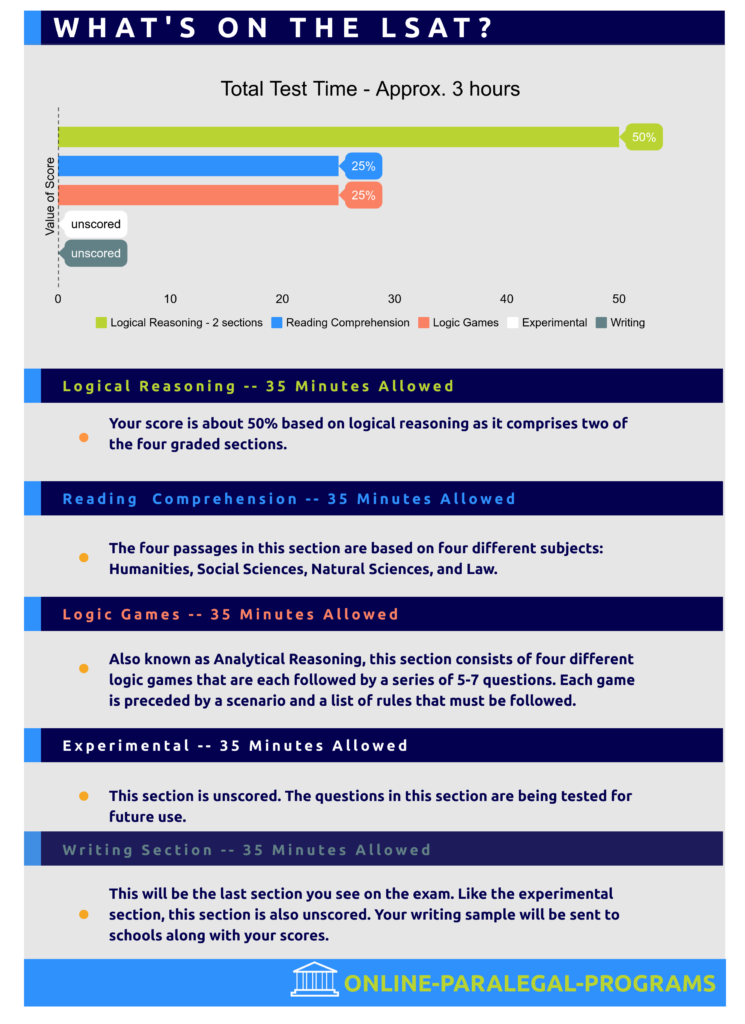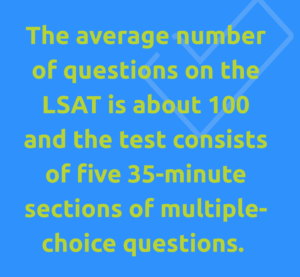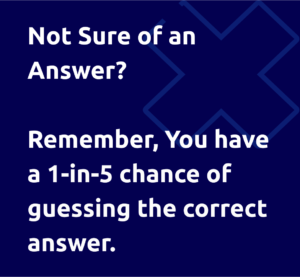If you have considered a career as an attorney at law while still in high school or college, it is likely you have asked the following questions:
- Can you take the LSAT in high school?
- What is the LSAT test?
- Can anyone take the LSAT?
What is the LSAT Test?
The Law School Admission Test (colloquially known as the LSAT) is quite unique and probably unlike any other exam you have taken throughout your schooling. The LSAT is specifically designed as a skills-based exam that assesses analytical thinking and reading skills — two significant skills that are critical for success in law school as a student.

The Law School Admission Test is one of the two requirements that you must possess before you will be able to apply to any law school in the United States.
A law school applicant must have–
- A high-school diploma
- An undergraduate degree (this generally takes four years to complete) from an American Bar Association (ABA)-an accredited institution of higher learning
- Already taken the Law School Admissions Test (LSAT)
So, the answer to the question —Can anyone take the LSAT?— is that anyone can take the LSAT if they meet the above-noted qualifications.
What is the LSAT Result Used For?
As noted above, the LSAT is an entrance examination. The LSAT score must accompany the application for admission to an ABA-approved law school degree program.
The result of your LSAT examination is a significant part of the law school application process. The list that follows includes some other items that law school application committees consider–
- LSAT Score.
- Your Grade Point Average (GPA).
- The completed application to the law degree program.
- Letters of Recommendation.
- A personal statement, if required.
- Any other information requested by the law school you are applying to.
As logic dictates, the higher one scores on the Law School Admission Test, the more law school academic options from which to choose.
How to Prepare for the LSAT
The LSAT is designed as a multiple-choice examination divided into four sections and a writing sample. The Law School Admission Council is responsible for the content found in the LSAT sections, the LSAT questions, and the LSAT syllabus.
To optimize your LSAT score, it is imperative to begin a serious LSAT prep. This begins with learning how to study for the LSAT, and discovering what is on the LSAT. LSAT prep help is available in specialized LSAT books, online, and even available in professional schools and community colleges.
These tools and techniques offer detailed explanations as to what is the LSAT is like and what to expect when learning how to study for the LSAT exam. Additionally, these free LSAT diagnostic tools are great throughout your LSAT preparation schedule.

The most prudent LSAT prep is to have a comprehensive understanding of what is assessed in each of the LSAT sections. LSAT books and other resources detail the LSAT sections and LSAT syllabus as noted below.
Are We Still in a Law School Bubble?
The Law School Bubble Has Burst
How to Prepare for the LSAT: What is On the LSAT?
Section #1 — Logical Reasoning
- Questions – 24 –26.
- Time Allowed —35 minutes.
The first Logical Reasoning Section of the LSAT is designed to assess the candidate’s ability to evaluate the validity and analyze an argument. This includes determining if, and how, an argument is weak or strong.
Section #2 — Logical Reasoning
- Questions – 24–26.
- Time Allowed —35 minutes.
The second Logical Reasoning Section is similar to the first logical reasoning section; the only difference is that the questions (in content, not substance) on section 2 differ from those on logical reasoning section number 1.
Section #3 — Analytic Reasoning
- Questions – 23–24.
- Time Allowed —35 minutes.
The Analytical Reasoning Section (i.e. the Logic Games) seeks to evaluate the test-taker’s skills of deductive reasoning by being tasked with the responsibility of structuring a subset of related data given in the question. Other assessments include the skills of sequencing and matching.
Section #4 — Reading Comprehension
- Questions – 26–28.
- Time Allowed —35 minutes.
The Reading Comprehension section is designed to evaluate the test-taker’s reading and comprehension of a scholarly narrative. LSAT candidates are tasked with inference interpretation, passage extrapolations and the identification of the narrative’s details and the fundamental ideas.
Writing Sample Essay
- 1 Essay.
- Time Allowed —35 minutes.
The Writing Sample Section is an ungraded section. The purpose of the writing section is to provide law school admission committees with a law school applicant’s writing sample; which may be used in the admission process. In general, the LSAT test-taker must, within the writing sample, defend one position in the argument while demonstrating the worthlessness of the opposing position.
Are you still wondering – What is the LSAT like? Read on to answer the rest of your questions.
How to Take the LSAT?
The Law School Admission Council administers the Law School Admission Test throughout the country and even in Canada.
Where do you take the LSAT?
There are hundreds of LSAT test centers available to LSAT candidates.
LSAT Test Dates
The LSAT Test dates are scheduled throughout these LSAT test centers seven times each year (since 2018); generally, in February, June, October, and December. Remember to be cognizant of the fact that when you choose from the LSAT test dates, you need to give yourself enough time before the relevant law school application deadlines arrive.
LSAT Registration Deadline
Similar to law school application deadlines, the LSAT Registration deadline is important to ensure you can sit for the test. While there are hundreds of test sites, seating capacity is limited (and offered on a first-come, first-served basis); this is important to consider as the testing site might max out capacity before the LSAT registration deadline.
LSAT Registration Fee
- LSAT Registration Fee —$200— for the calendar year 2019-2020.
It is noted that there are other fees associated with taking the LSAT examination, like–
- The Law School Report.
- Change of testing center or testing date.
- Hand scoring, to name a few.
How long is the LSAT?
The LSAT includes four sections and one writing essay –each section has a maximum time limit of 35 minutes each. The true answer to the question —How long is the LSAT?— 175 minutes is you use all allocated time.
How Do I Get a Good Score on the LSAT?
The LSAT Test Score Facts
- The LSAT Scoring Range is 120–180.
- Each question is equally weighted.
- The LSAT is a raw score; it is calculated based on how many questions we answered correctly.
- Unanswered questions are scored as incorrect answers; therefore, there is no consequence for taking a guess.
What is the average LSAT score? —151.
What is a good score on the LSAT?
It is a bit more amorphous defining what is a good score on the LSAT? Generally, test-takers who score above 160 are considered high performers.
What is the LSAT out of the total possible score, that is considered a below-average score? Those LSAT test-takers who score below 140 points, is considered to have a below-average score.
Is an LSAT Practice Test Worth It?
In the digital world, LSAT test-takers have a plethora of options to take an LSAT practice test online; with many LSAT practice questions free of charge. After spending sufficient time preparing, it is a prudent idea to take an LSAT practice test, as often as needed. This generally leads to the question –How many LSAT practice tests should I take? The reality is each individual will decide when they have taken enough free practice LSAT tests and are ready to sit for the exam.

It is also a smart idea to take a free practice LSAT test before you begin to prepare for the actual exam, which can be used as a baseline as you near the LSAT test date. By completing an LSAT practice test you can reinforce your knowledge (with LSAT practice questions free) and realize which section needs an extra effort.
Can you take the LSAT more than once?
As of September 2019, has the following retesting options:
- 3 times in one testing year
- 5 times with five testing years
- 7 times in a lifetime
How hard is the LSAT?
As with any standardized test, the difficulty of the LSAT depends on the student and their level of preparation. Good pre-law programs will prepare their students for the LSAT, with coursework and exams specifically designed to meet the demands of the exam. It’s worth noting, though, that many LSAT takers were not pre-law majors, and they still manage to pass. The LSAT is an examination of general knowledge, from mathematics to writing, so a strong liberal arts and sciences foundation is theoretically enough to do the job.
However, there is no shame in not passing the LSAT the first time. According to research, around 75% of test-takers are first-timers, while the rest are on their second or third go-around. Very few people take it more than three times, but very few people would need to – most dedicated students will pass the first or second time.
So have no fear – the LSAT is really just one more hoop you’ll have to jump through in your journey to become an attorney. It’s not the easiest, and it’s not the hardest, but buckle down and get ready – you can do it.
Related: